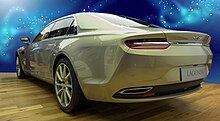Lagonda Taraf
Designed by Marek Reichman and considered "the finest of fast cars" by Aston Martin,[4][5] the vehicle is based upon the vertical–horizontal platform, which it shares with the DB9 and Rapide.
Initially intended for sale exclusively in the Middle Eastern market with a limited run of 100 units, Aston Martin later expanded the car's availability to several other countries and ultimately built 120.
[29] The project was carried out by Aston Martin's Q division, which specialises in creating bespoke cars and customising existing models to meet customer specifications.
[32] The official manufacture began in the subsequent year at the facility in Gaydon, Warwickshire,[3][33][34] with Aston Martin stating that 100 cars would be built exclusively for the Middle Eastern market.
[35][36] However, the chief executive officer of Aston Martin Andy Palmer expanded the potential markets for the car to include Europe, the United States, Singapore and South Africa.
[49][34] Instead of the Rapide's pressed aluminium body, the Taraf features a lightweight carbon fibre exterior; consequently, despite the latter's larger size, both cars are of similar weight.
[56] Mike Duff of Car and Driver emphasised the light yet responsive hydraulic steering and the chassis's impressive lateral grip, even in wet conditions.
He also noted that "[t]he brakes lack much initial bite but have plenty of stopping power when worked more forcefully," adding that it is "downright hard not to drive at the sort of speeds that would produce complaints from any rear-seat occupants—or possibly a sharp tap from a gold-tipped cane".
[52] Reviewing for Motor Trend, Angus MacKenzie wrote that "[t]his $1 million saloon, hand-built by Aston Martin, costs more than five times as much as a Mercedes-Maybach S600.
[2] The Autocar magazine also criticised its price, noting that for the same amount, one could buy a Rolls-Royce Phantom Coupé, a Bentley Mulsanne and a Range Rover SV Autobiography, but acknowledged the "unmatched exclusivity" of the car.


